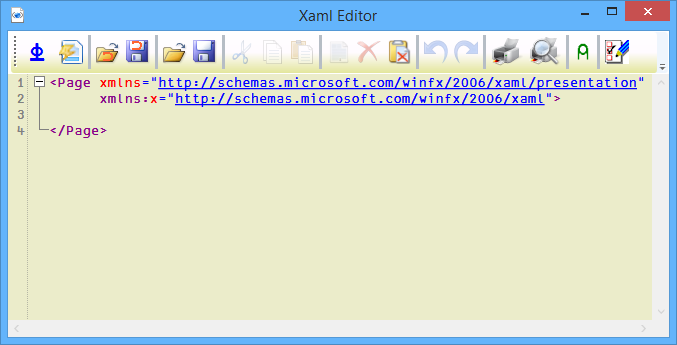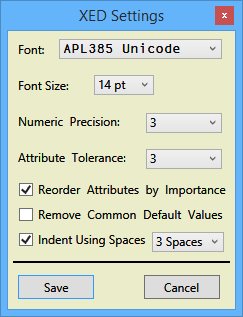wpfXamlEditor
UNDER CONSTRUCTION
Overview
XamlEditor is a Xaml editor for an APL variable or for a file on disk. This user command is able to show the Xaml in color with folding, print it, reorganize it so it is more readable according to some settings set by the user. It is inspired by the work of Robby Ingebretsen of Kaxaml (http://www.Kaxaml.com). It is particularly valuable for APLers that like to keep their Xaml in the workspace. With XamlEditor they have a tool to maintain it without effort.
Usage
Once installed the user command can be invoke by typing ]XamlEditor (casing is not important, no argument). The following start-up screen will appear:

Here is a short description for each buttons:
Button |
Explanation |
Button |
Explanation |
|
Execute the Xaml and Show the Result in a Separate Window |
|
Select All the Xaml |
|
Scrub the Xaml According to Settings |
|
Delete the Selected Text |
|
Open a Dialog Box to Select a Xaml Variable in the WS |
|
Clear the Clipboard |
|
Open a Dialog Box to Save the Xaml as a Variable in the WS |
|
Undo Last Operation |
|
Open a Dialog Box to Select a File on Disk |
|
Redo Previous Operation |
|
Open a Dialog Box to Save the Xaml to a File |
|
Print All the Xaml |
|
Cut the Selected Text to The Clipboard |
|
Print Preview All the Xaml |
|
Copy the Selected Text to the Clipboard |
|
Make Selected Text a Comment |
|
Paste the Text From the clipboard |
|
Choose the Settings when Scrubbing |
Installation
Download the file wpfXamlEditor.1.0.zip. It contains the Dyalog user command file wpfXamlEditor.dyalog and a dll named ICSharpCode.AvalonEdit.dll
Copy the file wpfXamlEditor.dyalog to your user command directory (for advice how to organize your User Commands see UserCommands/WhereShouldTheyGo).
Copy the file ICSharpCode.AvalonEdit.dll to the same directory as your dyalog.exe file (as shown by doing +2 ⎕NQ'.' 'GetEnvironment' 'Dyalog')(you may need administrator privileges for doing that). That dll is free of charge and was written by Daniel Grunwald. It can be downloaded from CodeProject or from AvalonEdit but is included in the zip file for commodity.
Detailed Explanations
|
Execute the Xaml and Show the Result in a Separate Window |
The Xaml will be parsed and show in a separate window. If the root element of the Xaml is not a window it will be made the content of a new window. The x:Class attribute will be removed if present. All the events will be removed before parsing the Xaml by the function ScrubAndFix. It does not rely on a prefix to removed the events. ( Show ScrubAndFix )
|
Scrub the Xaml According to Settings |
|
Open a Dialog Box to Select a Xaml Variable in the WS |
|
Open a Dialog Box to Save the Xaml as a Variable in the WS |
The dialog box contains a tree element where each branch is a namespace that has a character variable that responded positive to the following test: '><'≡¯2↑1⌽variableName~⎕UCS 32 10 13 9 (first and last character is '<>' after removing the space,LF,NL,HT characters)
|
Open a Dialog Box to Select a File on Disk |
|
Open a Dialog Box to Save the Xaml to a File |
A standard OpenFileDialog and SaveFileDialog are used to select and save the file.
|
Print All the Xaml |
|
Print Preview All the Xaml |
Will take the Xaml to a FlowDocument where it can be preview or print directly.
|
Make Selected Text a Comment |
The following rules applied to this button when clicked:
If nothing is selected it will insert '<!-- -->' at the caret.
If the selection is positive to the test: ' --><!-- '≡9↑¯4⌽selectedText, the comments are removed.
Otherwise it will insert: '<!-- ',selectedText,' -->'
|
Choose the Settings when Scrubbing |
The settings for scrubbing are saved in a xml file named XED.Settings.xml. The file will be created automatically with default values the first time the user command runs. It will be located next to the wpfXamlEditor.dyalog file or in the AppData directory depending on the Windows version and security. The data of the file looks like this:
1 <Settings>
2 <EditorFont>APL385 Unicode</EditorFont>
3 <EditorFontSize>14</EditorFontSize>
4 <ReducePrecision>0</ReducePrecision>
5 <Precision>10</Precision>
6 <AttributeCounteTolerance>2</AttributeCounteTolerance>
7 <ReorderAttributes>1</ReorderAttributes>
8 <RemoveCommonDefaultValues>1</RemoveCommonDefaultValues>
9 <ConvertTabsToSpaces>1</ConvertTabsToSpaces>
10 <SpaceCount>2</SpaceCount>
11 </Settings>
It is used to build the Settings window (button ![]() of the command bar).
of the command bar).

Look at the individual tooltips on the Window for more information on each settings.
Version Information
Original author: |
Pierre Gilbert |
Responsible: |
|
Email: |
<apgil AT SPAMFREE videotron DOT ca> |
 APL Wiki
APL Wiki